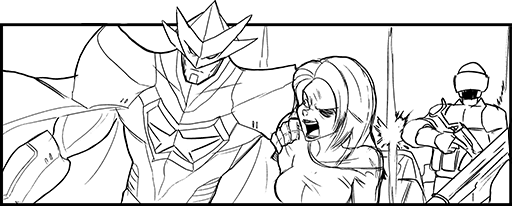Last night I made two comments that drew an amount of attention. Well, three, actually. Allow me to explain:
First, as a result of Marvel badly misplaying its hand in an attempt to bypass the two major comics distributors and go direct-to-dealer in the late 90s, Diamond managed to establish a near-monopoly over the comics distribution business. Like all monopolies, their customer service has gone downhill as their prices have risen. If you combine their own reports on total retail sales with Hoover’s report on their annual revenue, Diamond takes 22 percent of the total retail dollar that goes through the comics stores. That amounts to a 37 percent markup, 17 points and 85 percent more than is normal for a distribution business.
It’s good to be the monopolist. The additional markup amounts to $55.8 million annually, or $31,885 in lost profit to each of the 1,750+ brick-and-mortar comics stores in the USA. It’s no wonder these stores are struggling or that long-established retail establishments are closing down everywhere from Arizona to Iowa and Sacramento. Diamond isn’t evil or even particularly rapacious, they are simply failing to recognize that they have been devouring their own seed corn. The rise of digital delivery systems combined with the shrinking physical channel is going to place Diamond in an increasingly difficult position; I would expect them to buy some of the independent publishers and get into content production themselves as time goes on, since from what I hear they are pretty smart.
Second, we have found it difficult to establish Alpenwolf even though we have completed one DevGame game and have several others in various stages of development because the major free game sites, Addicting Games and Kongregate, have kept changing their strategies in ways that make it difficult to work for them. Since we already built a complete virtual goods and virtual currency infrastructure, there is no reason why we shouldn’t simply launch our own free-to-play site. It’s going to be very small by gaming standards, and will probably launch with 3-5 games, but at least we’ll have a vehicle for getting our games out there to the gamers. From there, its simply a matter of building traffic and that’s not a challenge that frightens us. Frankly, it’s probably preferable to be able to grow slowly and steadily int his regard. Look for announcements asking for volunteers concerning forum moderation and writing trivia questions for everything from the NFL and NCAA football to comics and television shows in the next few months.
Third, if you think Neil Gaiman is a great novelist, or even a great SF/F novelist, you are simply wrong. He is a successful, talented and much-loved SF/F author, and understandably so, but he is also little more than a very successful stunt writer with two or three tricks in his bag. There is a reason that all of his notable books involve mythology of one sort or another; his true gift is translating ancient myth into a form that pleases postmodern palates. He also has the ability to convey that sense of the numinous that I lack. But Neal Stephenson, William Gibson, Alan Moore, John C. Wright, China Mieville, Nick Cole, and even George R.R. Martin are all better, more original SF/F writers with considerably more to say about the human condition than Gaiman.
When I have thought about the writers whose work I would like to be able to emulate or surpass over the years, Neil Gaiman never once entered into the equation, not even for a moment. Consider that American Gods is described as “Neil Gaiman’s best and most ambitious novel yet.” I liked that story considerably better when it was called Long Dark Tea-Time of the Soul and On the Road. That being said, of the various comics I have read, Sandman is head-and-shoulders above the rest.
As for my own writing, you might contemplate this: How many other authors flow as easily across as broad a range of genres as I do? How many authors have historically done so? Perhaps my inability to focus precludes achieving greatness in any one genre, but I think that sort of unusual breadth at least merits consideration.
UPDATE: this guy has a skeptical, but reasonable perspective on the situation.
To say Arkhaven has been controversial is an understatement. From the moment the company’s flagship title, Alt-Hero, was announced the internet was debating whether a right wing perspective would “save” comics, or further damage an already fractured industry. But as I said before, what’s lacking is a shared notion of what “saving comics” really means. That said, there is a general consensus that Mark Waid’s head on pike would be a good start. Which brings us back to Vox Day and Arkhaven. Most criticism directed toward Vox can be boiled down to: “The last thing comics needs is another goddamn writer with an agenda.”
A self-described libertarian nationalist and member of the Alt-Right, Vox Day has never been shy about his politics. Likewise, his yet to be release Alt-Hero series looks to be something of a satire of today’s overly politicized comics. The project is still months away from completion, so for now we’ll just have to wait and see. In the meantime, Arkhaven has two titles digitally available on Amazon—Quantum Mortis and Right Ho, Jeeves. Both are selling well. Neither are political in nature. And there’s the rub—Alt-Hero could be a political screed. Then again, maybe not. But so far Arkhaven’s catalog hasn’t shown itself to be a mouthpiece for anybody’s politics. If only we could say the same for Marvel.
Does this signal a new dawn for comics? Well, if bringing content to an ignored demographic is Arkhaven’s end goal, it’s not a bad start. And drawing new readers to the medium is a net gain for everyone. But as Green Lantern artist Ethan Van Sciver has been quick to point out, the company currently has no presence in Diamond’s monthly Previews catalog, which is a prerequisite for getting books stocked in comic book stores. And in Sciver’s eyes, if a company isn’t moving product through brick-and-mortar shops, it’s contributing absolutely nothing to the overall health of the industry.
I’ll be blunt, if Arkhaven can eventually become successful enough to provide comics shops with enough monthly product to pay the rent, Vox will not only save the industry, he’ll be the motherfucking Batman.
Better yet, the Shade.



